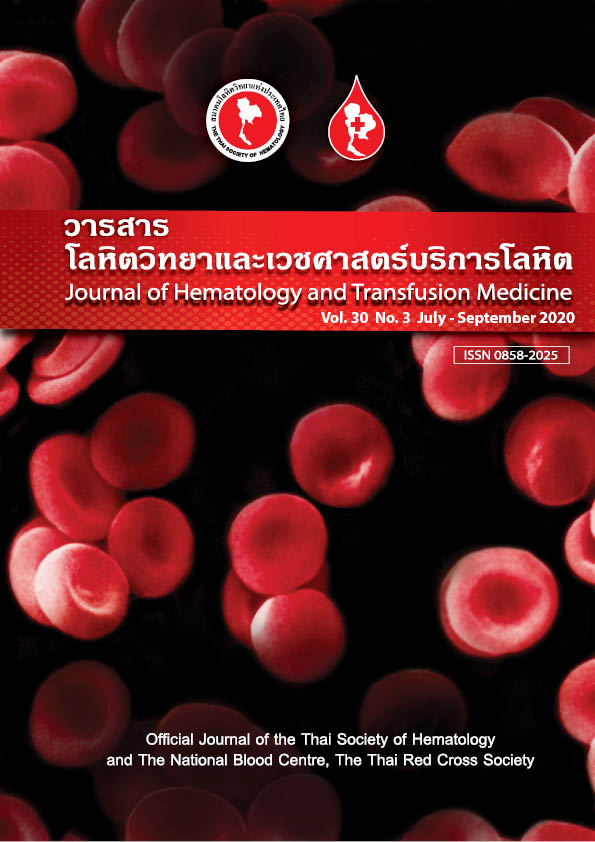ปัจจัยที่ส่งผลต่อการทดสอบ HLA crossmatch ก่อนการปลูกถ่ายไตจากผู้บริจาคไตสมองตาย
Keywords:
HLA crossmatch, Deceased donors, Kidney transplantationAbstract
บทคัดย่อ
บทนำ การปลูกถ่ายไตจากผู้บริจาคสมองตายให้กับผู้ป่วยที่ขึ้นทะเบียนรอรับการปลูกถ่ายไต มีหลายปัจจัยที่เกี่ยวข้องตั้งแต่ระยะเวลา การผ่าตัดอวัยวะของผู้บริจาคจนได้ปลูกถ่ายไตให้กับผู้ป่วย ดังนั้นการจัดส่งไตและสิ่งส่งตรวจม้ามและ/หรือต่อมน้ำเหลืองมายังห้องปฏิบัติการ ต้องมีการเก็บในน้ำยาที่ถูกต้องและในอุณหภูมิเหมาะสม อีกปัจจัยหนึ่งที่ส่งผลต่อการปลูกถ่ายไต คือ ระยะเวลาตั้งแต่รับตัวอย่างส่งตรวจจนถึงรายงานผล HLA crossmatch (Turnaround Time, TAT) วัตถุประสงค์ เพื่อศึกษาข้อมูลย้อนหลังเกี่ยวกับปัจจัยที่ส่งผลต่อการทดสอบ HLA crossmatch ก่อนการปลูกถ่ายไตจากผู้บริจาคไตสมองตาย วัสดุและวิธีการ ศึกษาข้อมูลจำนวนไตที่ไม่สามารถปลูกถ่ายได้ และ TAT วิธี complement-dependent cytotoxicity (CDC) และ CDC-Antihuman globulin (CDC-AHG) สำหรับการปลูกถ่ายไตจากผู้บริจาคไตสมองตายให้กับผู้ป่วยที่ขึ้นทะเบียนรอรับการปลูกถ่ายไต ของศูนย์รับบริจาคอวัยวะสภากาชาดไทย และศูนย์บริการโลหิตแห่งชาติ สภากาชาดไทย ผลการศึกษา ในผู้บริจาคไตสมองตายจำนวน 1,233 ราย ซึ่งมีแนวโน้มสูงขึ้นทุกปี พบว่าไม่สามารถใช้สิ่งส่งตรวจจากผู้บริจาคไตเพื่อทดสอบ HLA crossmatch ได้ จำนวน 14 ราย (1.13%) เพราะ cell low viability 13 ราย (1.05%) และอีก 1 ราย (0.08%) เกิดจากจำนวนเซลล์ไม่เพียงพอ ส่วนระยะเวลาการทดสอบตั้งแต่ได้รับตัวอย่างม้ามและ/หรือต่อมน้ำเหลืองของผู้บริจาคไตสมองตายจนถึงเวลาที่ห้องปฏิบัติการรายงานผลไปยังศูนย์รับบริจาคอวัยวะสภากาชาดไทย ส่วนใหญ่ประมาณ 5 ถึง 6 ชั่วโมง สรุป ปัจจัยสำคัญที่ส่งผลต่อเวลาการทดสอบ HLA crossmatch ก่อนการปลูกถ่ายไตจากผู้บริจาคไตสมองตาย คือ การเก็บและขนส่งสิ่งส่งตรวจ และการบริหารจัดการทางห้องปฏิบัติการให้มีคุณภาพ เพื่อรองรับกับจำนวนผู้บริจาคไตสมองตายที่เพิ่มขึ้น
Abstract:
Introduction: Factor affecting the waiting list for deceased donor kidney transplantation is the retrieval time of the donor’s organs until a transplant kidney has been given to the patient. Hence, the delivery of the spleen and/or lymph nodes to the laboratory must be kept in the transport medium at the appropriate temperature. Besides, the HLA crossmatch testing time is another factor affecting kidney transplantation. Objective: To study retrospective information about factors affecting the HLA crossmatch test for kidney transplantation from deceased donors. Materials and Methods: The numbers of kidneys that could not be transplanted and the duration of the HLA crossmatch test using complement-dependent cytotoxicity (CDC) and CDC-Antihuman globulin (CDC-AHG) for kidney transplantation from deceased donors to the waited-list patient candidates on waiting list of the Organ Donation Centre and the National Blood Centre, Thai Red Cross Society, to receive a kidney transplant were studied. Results: The total number of deceased donors was 1,233 cases with an upward trend every year. Fourteen samples from the deceased donors (1.13%) could not be used for HLA crossmatch test, owing to cell low viability (n= 13, 1.05%) and cell insufficiency for testing (n=1, 0.08%). Moreover, the duration of testing time was approximately 5 to 6 hours, starting from obtaining the spleen and/or lymph nodes of the deceased donors to the time that the laboratory reported the results to the Organ Donation Centre. Conclusion: The important factors affecting the HLA crossmatching time before deceased donor kidney transplantation including not only specimen transportation but also the quality of laboratory management would be beneficial to support the increasing number of deceased kidney donors.



